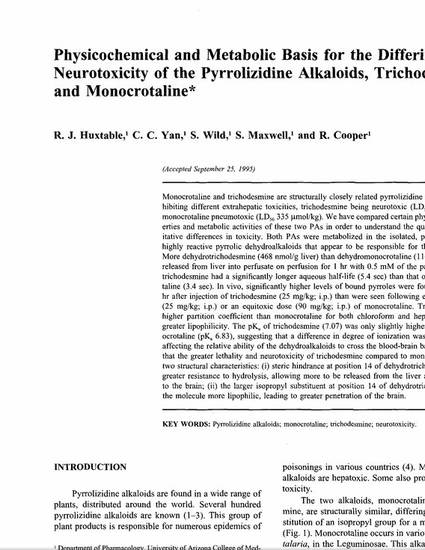
Article
Physicochemical and metabolic basis for the differing neurotoxicity of the pyrrolizidine alkaloids, trichodesmine and monocrotaline
Neurochemical Research
(1996)
Abstract
Monocrotaline and trichodesmine are structurally closely related pyrrolizidine alkaloids (PAs) exhibiting different extrahepatic toxicities, trichodesmine being neurotoxic (LD(50) 57 mu mol/kg) and monocrotaline pneumotoxic (LD(50) 335 mu mol/kg). We have compared certain physicochemical properties and metabolic activities of these two PAs in order to understand the quantitative and qualitative differences in toxicity. Both PAs were metabolized in the isolated, perfused rat liver to highly reactive pyrrolic dehydroalkaloids that appear to be responsible for the toxicity of PAs. More dehydrotrichodesmine (468 nmol/g liver) than dehydromonocrotaline (116 nmol/g liver) was released from liver into perfusate on perfusion for 1 hr with 0.5 mM of the parent PA. Dehydrotrichodesmine had a significantly longer aqueous half-life (5.4 sec) than that of dehydromonocrotaline (3.4 sec). In vivo, significantly higher levels of bound pyrroles were found in the brain 18 hr after injection of trichodesmine (25 mg/kg; i.p.) than were seen following either an equal dose (25 mg/kg; i.p.) or an equitoxic dose (90 mg/kg; i.p.) of monocrotaline. Trichodesmine had a higher partition coefficient than monocrotaline for both chloroform and heptane, indicating its greater lipophilicity. The pK(a) of trichodesmine (7.07) was only slightly higher than that of monocrotaline (pK(a¿ 6.83), suggesting that a difference in degree of ionization was not a major factor affecting the relative ability of the dehydroalkaloids to cross the blood-brain barrier. We conclude that the greater lethality and neurotoxicity of trichodesmine compared to monocrotaline is due to two structural characteristics: (i) steric hindrance at position 14 of dehydrotrichodesmine results in greater resistance to hydrolysis, allowing more to be released from the liver and to be delivered to the brain; (ii) the larger isopropyl substituent at position 14 of dehydrotrichodesmine renders the molecule more lipophilic, leading to greater penetration of the brain.
Keywords
- Pyrrolizidine alkaloids,
- monocrotaline,
- trichodesmine,
- neurotoxicity
Disciplines
Publication Date
February, 1996
Citation Information
R. J. Huxtable, C. C. Yan, S. Wild, S. Maxwell, et al.. "Physicochemical and metabolic basis for the differing neurotoxicity of the pyrrolizidine alkaloids, trichodesmine and monocrotaline" Neurochemical Research Vol. 21 Iss. 2 (1996) p. 141 - 146 ISSN: 0364-3190 Available at: http://works.bepress.com/roland_cooper/4/
